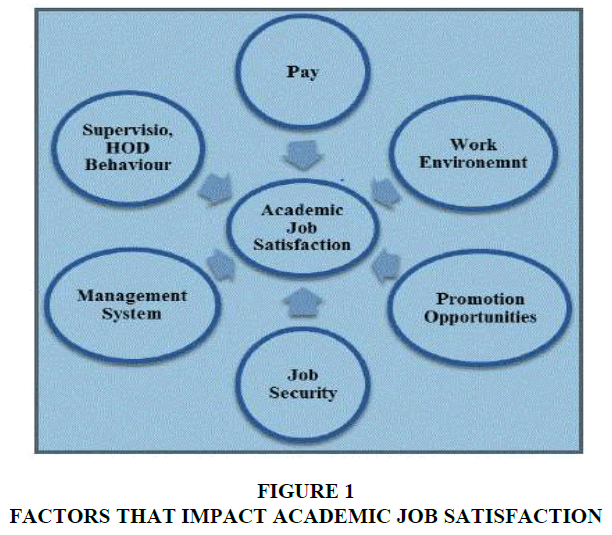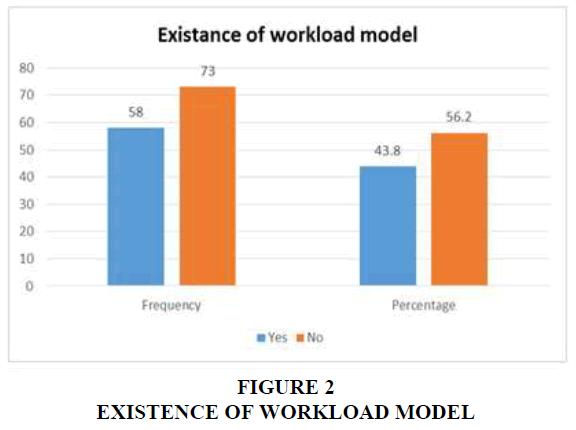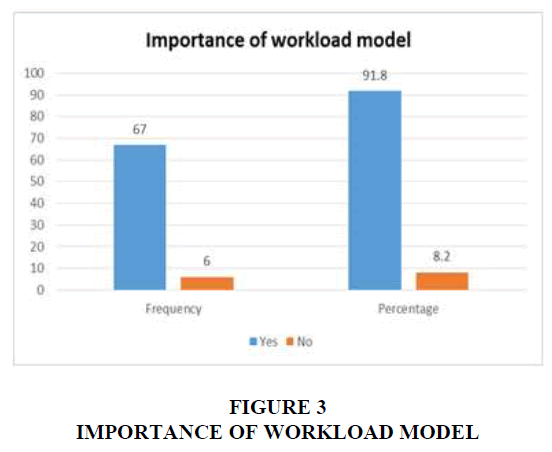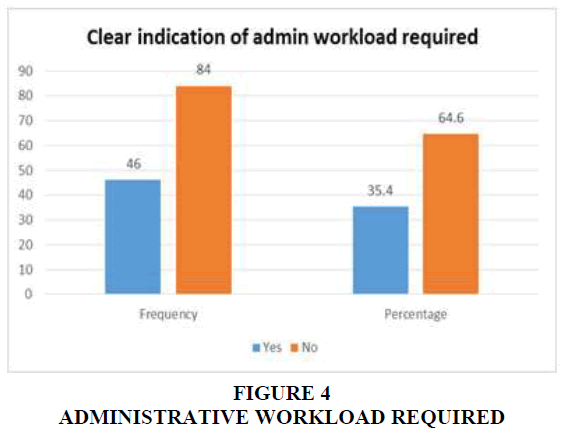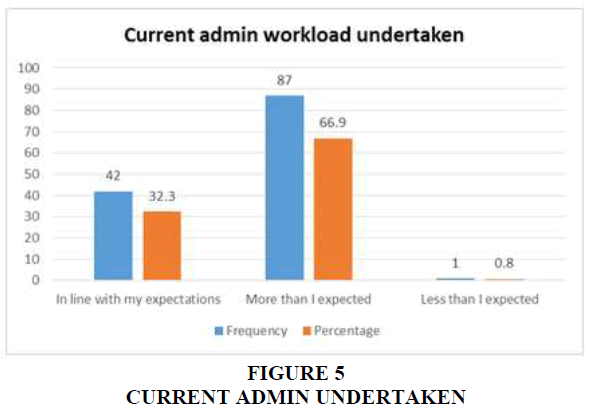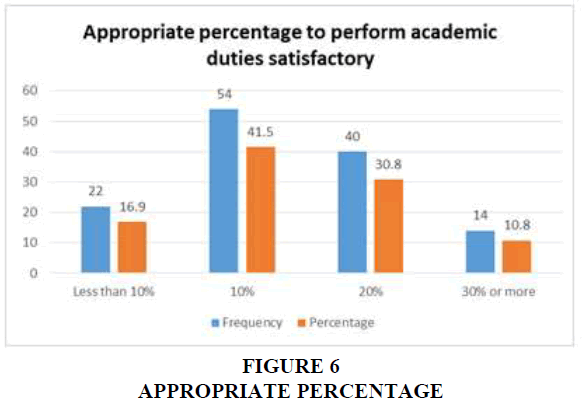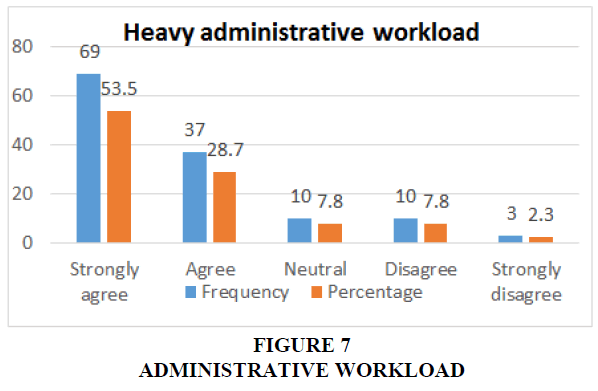Research Article: 2019 Vol: 23 Issue: 4
Workload Models and Entrepreneurial Administration for Strategic Academic Staff Support in South African Higher Education Institutions
Bongani Penuel Qwabe, Mangosuthu University of Technology
Abstract
This paper aimed at setting out the findings from an examination of academic staff member perceptions, with regard to support strategies afforded to academics at higher education institutions, using the Durban University of Technology as a case study. Even though much research has undertaken where the academic workload experienced by academics is concerned, little has been done to investigate actual support strategies that can be employed, in order to address some of the challenges faced by academics. In addition, despite the importance of entrepreneurial administration in practice, researchers have not examined entrepreneurial leadership’s role in stimulating policy innovation or its contribution to higher learning institutions. A mixed methods approach was used to collect and analyses primary data from 130 academic staff members of the Durban University of Technology, with data drawn from questionnaires personally dispersed to respondents and followed up telephonically. The findings show some confusion exists within the university, as to the existence of an academic workload policy or model and strategic support for academic staff. This study further reports the majority of academics believe a workload model and policy could assist in safeguarding a reasonable workload balance, however, some individual sentiments indicated the difficulties and shortcomings to be tackled, in order to allow flexible and on-going staff member consultation, prior to implementation of such a model. Extensive consultation is recommended over implementation of the study’s proposed findings and a workload model, with employment of a pilot phase, in order to eliminate any problems that may occur.
Keywords
Support Strategies, Strategic Support, Workload, Academic Staff, Higher Education Institutions.
Introduction
Effective administration is dependent on entrepreneurial leadership, which according to Weiser (2011), can drive experimentation with policy and problem-solving through trial-anderror, as well the use of non-traditional tools for program development. Academic staff members have seen an extensive increase in their workload, to the extent where effective work allocation mechanisms have now become crucial (Kenny & Fluck, 2014). Kyvik (2013), on the one hand, reveals a strong belief by many academic staff of increased work and task performance expectations, leading to task performance beyond their scope of work. On the other hand, Kordzadze (2013) maintains workload policy does not capture the entire range and complexity of activities undertaken by academic staff members and only formal teaching time is implicated under academic workload. He further argues paying more attention to teaching hours and neglecting research and administrative loads is not proper, as this is neither perceived as equitable nor does it result in the most effective use of academic staff member time. It is, therefore, of paramount importance for academic staff to be afforded sufficient support, allowing uninterrupted performance of academic duties. While recent studies see academic workload policy as a strong weapon that can be utilized as a strategy to address issues faced by academics in Higher Education Institutions (HEIs), particularly in developing countries, such as South Africa.
Considering that entrepreneurial leaders in government are able to, as Weiser (2012: 2017)) explains, free their agencies from the mental grip of conventional structures on the capacity to consider alternatives, these leaders could, by doing so, enable alternative strategy development. Government agencies are, likewise, faced with the challenge to overcome what the author refers to as institutional bias, where specialist in their respective fields concentrate myopically on matters in their field, in the process, not recognizing the benefit of being able to access other bodies of knowledge or ways of thinking in decision-making. Weiser (2012 further asserts that, in government, entrepreneurial leadership explore challenges through the lens of first principles” and the concept of policy entrepreneurship acknowledges an entrepreneurial mindset and skillset can be applied to governance to foster innovative results. Moreover, with academic staff members participating in community engagement activities and other services, on behalf of the university-workshops, conferences, board meetings, and so on-innovation and an entrepreneurial approach to administration could offer possible solutions. Therefore, this research sought to show discrepancies and problems regarding the existence of an academic workload policy and strategic support of staff within the university.
Statement of the Research Problem
Whereas the OECD (2012) maintain the key to entrepreneurship lies in overcoming bureaucratic barriers, it is also found that, where there are fewer hierarchies or barriers at HEIs, the process of decision-making and idea creation happens much faster, as does undertaking entrepreneurial activities. While much research has been conducted on academic workloads in Higher Education, research nonetheless indicates academics have, for decades, been experiencing difficulties and not much has been done to address their demands. Mohamed bhai (2011) found an already saturated workload had resulted in not only inefficient management of high ratios of students to staff, it had caused more administrative responsibilities and an extensive teaching workload that, as a result, impacts educational quality, with little attention and time spent on activities not related to teaching, such as research. There seems to be lack of support strategies the universities can use to curb challenges faced by academics on daily basis. The absence of these strategies has a negative impact on academics’ performance and it may also result on poor research output. These sentiments are supported by authors such as Vardi (2009), indicating dissatisfaction by many academics with both working hours, in general, and their workload, in specific, as they seem to be spending most of their time on administrative duties, which is not supposed to be case. The absence of a transparent academic workload model is one of the contributing factors to this phenomenon, which could account for the lack of strategic staff support, specifically with regard to administrative duties. Therefore, the study intended to close an existing gap and possibly provide meaningful recommendations the university could use to address the reported challenges.
Aim
The paper’s main aim is to present findings on an investigation of strategic support, given to academic staff members at HEIs, regarding their academic administrative workload.
Objectives
To achieve this aim, the paper addressed the objectives, which are to:
1. Ascertain academic staff member perceptions concerning the existence of strategic staff support at the selected Institute of Technology (DUT);
2. Examine the extent of academic staff member support, specifically in administrative duties; and
3. Propose suitable support strategies to assist with academic workload balance.
Literature Review
It is possible for HEIs to use an academic workload model, as a strategy to support academics to manage their unbearable administrative workload that seemingly increases daily, with national and international universities having employed such models to aid in achieving workloads for academics that are equitable, fair, safe, healthy and transparent (Boyd, 2014). It was further found the model has to be adjustable to accommodate a broad array of varied academic activities. The different activities performed by academic staff are identified by a workload model, prior to its allocation of respective individual time budgets, as agreed on in consultation. A clear and broad picture can thus be constructed by institutions and their staff, as explained by Perks (2013), regarding who is doing what and the amount of dedicated time spent. According to Tight (2010), workload as such, is not increasing; instead, the author asserts there has been an undesirable change in the academic and administrative work balance of the average academics’ workload.
Work Allocation Models (WAMs) have featured significantly in the academic employment field by means of, as Cargill, Nicholls & Ross (2008) explain, enabling “distribution of the various activities and tasks that academics must do as a part of their job”, in a logical and apparent manner. Further to this, the authors add use by universities of WAMs, combined with other tools for change management, particularly in contributing to increased research output, while highlighting WAMS as a useful tool in developing both the output and quality of research.
The growing workload of academic staff is a concern shared by the university community, as it may negatively impact student instruction quality, along with delivered research productivity (MEXT, 2009). An academic workload framework, as stated in a report by the Australian Catholic University (2013), provides clarity of academic work required and staff availability, while aligning these with the University’s strategic priorities. Academic workload activities that make up the framework include university service and administration, teaching and learning, professional activities, and research and scholarship, while simultaneously taking academic work’s changing nature into account.
Making use of a workload model can, according to Cawood et al. (2008), reduce emotional and prejudiced claims regarding workload by members of staff, in providing staff guidance with regard to the standard amount of time spent on various tasks and the volume of productive time understood to be needed for desired performance criteria to be achieved. The model can, furthermore, be made use of by Heads of Departments (HoDs) to allocate workloads that are equitable, such as ensuring certain subjects comprise of team-teaching, ensuring flexibility, and successful staff development planning, while capacity shortcomings are taken into account.
The following basic principles should be considered when developing and academic workload model (Ewing, 2012):
1. Academic level or seniority should not form the basis of teaching load or allocation but instead this should be done on the basis of output that ensures relative research;
2. As part of research output, publications that have a strong bias quality should probably be included, along with external income and completions;
3. Calculation of the teaching load should perhaps be adjusted for large classes, otherwise the computation and allocation would be best achieved either by hours per week or, using universal metrics, by units taught; and
4. The spread of the service load should be wide-ranging, applied throughout all staff levels, assigned based on academic level while, for simplicity’s sake, not included in the workload model.
Job Satisfaction of Academic Staff
The satisfaction felt by employees, regarding general aspects of their employment, is described as job satisfaction by Noordin & Jusoff (2009), and includes aspects such as remuneration, advancement and their relationship with management, as well as the actual job and prospects for promotion. Numerous similar factors were found by Al Hinai & Bajracharya (2014) that affect job satisfaction of academic staff at HEIs. The diagram below Figure 1 (Source: Al Hinai & Bajracharya (2014) illustrates factors affecting academic staff job satisfaction.
Many factors exist, according to Al Hinai & Bajracharya (2014), which university administration can employ to improve job satisfaction among academic staff. The work environment should, at all times, be experienced as the least acceptable by academics. As found by Clarke et al. (2015), challenges experienced by academic staff members impact on the creation of a supportive working environment and maintenance thereof. As example, insufficient remuneration could motivate an institution’s staff to leave when better paying posts become available. The relationship between academics and their supervisors or HODs could also potentially impact academic job satisfaction in a significant way. Further consideration must also be given to systems for management, along with job security and advancement opportunities, where academic job satisfaction is concerned.
Various authors emphasise that, within HEIs, the key resource is that of academic staff and they are vital to achieving the institution’s objectives (Machado et al., 2011; Al Hinai & Bajracharya, 2014). In addition, much of the student success is determined by academic staff performance, which also impacts student learning. This makes motivating academic staff and their job satisfaction crucial to achieving worthwhile staff performance and quality HEIs, however, sound secretarial support still needs to form part of the basis of job satisfaction.
Seen as a key predictor of work behaviours, including low turnover and absenteeism and good organizational citizenship, by Mustapha & Ghee (2013), job satisfaction is also found to be essential among academics, contributing to the quality of teaching and additional commitment to the job, therefore ensuring students can attain academic performance of a high standard. Understanding job satisfaction levels of academic staff can assist HEIs in finding the means to hold onto academic abilities, while enticing new employees of good quality, decrease the rate of turnover and reduce absenteeism. For universities to achieve adequate staff allocations, Froeschle & Sinkford (2009) suggest an increase in job satisfaction and greater employee retention.
Academic staff’s attitude is severely affected by their working environment, which ought to, preferably be a healthy and safe workplace, with good salary incentives, career development, and support for and of administration, of which the latter is significant to this study (Noordin & Jusoff, 2009). Encouragement of team work was also found to be important, as was peer support, along with interest in the job itself, as well as the challenge it holds. Moreover, job satisfaction is highlighted by Santhapparaj & Alam (2005) as having a clear relationship with various factors such as remuneration, prospects of promotion, fringe benefits, and working conditions, in addition to adequate research and teaching support and the absence of gender discrimination. A negative aspect that Bushe et al. (2012) point out, in detailing the principal factors that lead to high academic staff turnover, is that of academic staff members appointed on a non-permanent contract, which have to dedicate a disproportionate amount of time on administrative tasks, which is again significant for this research.
Retaining Academic Staff
Another strategy that universities can utilize to support its academic staff, is through academic retention programmes. Academic retention is described by Bernard (2012), as an institution’s ability to employ academic staffs that are well qualified, in addition to retaining competent staff by establishing measures including a quality work environment and working life, a staff climate that is motivated, making it possible to establish HEIs as an employer of choice. This has, regrettably, not been easy to accomplish, as many countries including South Africa, have proved in recent years, with Theron et al. (2014) expecting the demand for higher education academic staff to continue to escalate, while the supply is decreased or stays limited. The South African situation is worsened by The so-called ‘retirement swell’ has worsened the situation in South Africa, which at present involves losing experienced staff in large numbers, along with problems of high turnover and limited retention. The authors highlight the limited means of identifying these factors and addressing them.
It is agreed by Selesho & Naile (2014) that most HEIs are apprehensive with regards to employee retention and the authors state a major challenge is posed by the high rate of turnover of academic staff, with dire consequences for academic enterprise quality, consistency, and stability. Retaining academic staff is found to be crucial, being a major factor in ensuring universities accomplish their missions and visions, and develop into centers of excellence (Ng’ethe et al., 2012).
Management System
With considerable flexibility that allows for a range of alternative options…within current structures…bureaucratic inertia and autopilot administration do not just preclude the development of innovative programs, it can also result in existing programs being badly administered (Weiser, 2012; 2017). Current HEI structures have, unfortunately, not drawn on either innovation or entrepreneurial approaches; instead they are simply piling new responsibilities onto a broken system. Weiser (2012; 2017) does, however, add that although the flaws in the current system are obvious, rather than change it, there is much pressure to continue using it.
Research Method
A mixed method approach was employed to collect primary data at the Durban University of Technology (DUT), targeting academic staff members from the institution’s six faculties. The design of a questionnaire, with which to obtain sufficient information about this study topic, was shaped by a review of literature and pretested with a pilot study. The questionnaire was comprised of open- and closed-ended questions and was administered personally to all participants. The sampling frame was made up of DUT academic staff members, with probability sampling used to select 130 academic staff members as respondents.
Questionnaire Design
A 5-point Likert scaled questionnaire, containing both open- and closed-ended questions, was adopted as measurement instrument for this study. The rating scale for the questionnaire ranged from strongly agrees to agree, neutral, strongly disagree and disagree. To allow respondents to add information that had possibly been left out of the Likert scaled questions, additional comment space was provided in the questionnaire. Clear words were used to construct the questions in order to address any issues of ambiguity. Table 1 summarizes the key questions/statements.
| Table 1 Summary of Key Questions | |
| Research area | Question/Statement |
| Existence of academic workload model (Academics) | A clear workload model exists within my department Response alternatives: 2 options |
| Clear indication about the administrative workload required | The administrative workload which I would be required to perform was made clear to me at the time of my appointment Response alternatives: 2 options |
| Importance of workload model | Such a workload model could identify a fair division of work for all staff members Response alternatives: 2 options |
| Heavy administrative workload | Academic staff who claim to experience a heavy administrative workload Response alternatives: Likert scale options |
| Current percentage devoted to administration | The perceived time expressed by academics as a percentage devoted to administration Response alternatives: 4 options |
| Clear admin workload undertaken | The administrative workload I currently undertake is Response alternatives: 3 options |
| Any additional information regarding workload policy | Indicate any additional ideas which you feel would help to improve the workload policy of the university. Response alternatives: Qualitative |
Data Analysis
Primary data, collected by means of a questionnaire, were captured and coded using the latest version of the Statistical Package for Social Sciences (SPSS). The data was scrutinized in order to ensure no capturing errors.
Frequencies
Used to determine how many responses each question received, frequencies were also employed to crosscheck data coding.
Validity and Reliability
Before being disseminated to respondents, the questionnaire was sent to a statistician to address possible validity and reliability issues. The response from the statistician was quite positive, with few questions having to be changed and rephrased. Furthermore, the questionnaire was pre-tested with a few academic staff members, ensuring the desired data was measured and collected, while a Cronbach’s alpha test was performed, to determine a coefficient of .738. The reliability of the study was thus indicated as acceptable by these results.
Research Findings
This section presents the key findings for this research. Completed questionnaires were received from 130 academic staff members. The information is presented in the form of graphs extracted with Microsoft Excel.
The first question was aimed to establish whether there is an existing workload model within the institution. The results (Figure 2) indicate 58 (43.8 percent) of the respondents agreed a clear workload model exists within their respective departments, with 73 (56.2 percent) indicating their disagreement that such a model exists in their departments. These percentages are noted to be quite close, indicating some confusion within the University on this point. On the other hand, findings (Figure 3) that the workload model would help to identify a fair division of work for all members reveal 67 (91.8 percent) of the respondents in agreement and only six (8.2 percent) respondents that did not agree. These results show the majority of academics believe the introduction of a workload model would assist in ensuring fair division of work for all staff members.
It is illustrated (Figure 4) that 84 (64.6 percent) of the respondents indicated they were given no clear indication about the administrative workload they would be required to perform at the time of their appointment, while only 46 (35.4 percent) indicated there was a clear indication of expected administrative workload. Whereas the findings (Figure 5) explain that 42 (32.3 percent) of the respondents indicated the administrative workload they currently undertake is in line with their expectations, 87 (66.9 percent) of the respondents disagreed, indicating it is more than they expected, and only one (0.8 percent) respondent indicated it is less than expected.
The results (Figure 6) reveal 22 (16.9 percent) of the respondents indicated they would have to spend less than 10 percent of their time on administration, to allow satisfactory performance of their academic duties. The largest proportion of 54 (41.5 percent) respondents indicated ten percent as adequate, while nearly a third (30.8 percent) of the respondents indicated 20 percent would be appropriate. Slightly more than ten percent of the respondents indicated they would allocate a proportion of 30 percent or more of their time to administrative duties. These findings show the majority of academic staff considers 10-20 percent of administrative duties as an appropriate percentage, to allow satisfactorily performing their academic duties. However, the previous figure shows that, in reality, most academics spend 30 percent or more of their time in this manner. As a result, the findings illustrate (Figure 7) a large majority of respondents (83 percent) either strongly agreed or agreed with the statement that they currently experience a heavy administrative workload, while ten (7.8 percent) respondents remained neutral and only 10.1 percent disagreed or strongly disagreed. These findings indicate most academic staff do indeed experience administrative workload as an important issue.
Respondents were also asked to indicate any additional ideas they felt would help improve the workload policy and support structures for academic staff of the university. A summary of qualitative responses received are set out in Table 2.
| Table 2 Summary of Respondent Suggestions and Drawbacks on Workload Policy/Model |
| SUGGESTIONS |
| Workload Model |
| Workload model development should make use of wide consultation; |
| A model encompassing supervision, research based on current output, teaching and community engagement. |
| Additional Staff needed |
| Support staff to assist with duties outside lecturing; |
| Employing admin assistants to help with this high load of admin work; |
| Assistant lecturers and more tutors; |
| Departments with a heavy research administration load should have research assistants appointed; |
| Assistance in terms of support for admin work could be achieved by undergraduate students providing support, while gaining work experience; |
| Additional staff for programmes with high enrolment figures. |
| Development of existing Staff |
| More academic support to free up time for research and continuous professional development; |
| A SWOT analysis of academic staff members to identify and develop their strengths; |
| Full support at the beginning of academic careers to upgrade qualifications; |
| Less administration and workload allows time for studies leading to improved academic qualifications to meet the university’s goals and expectations; |
| Research should be differentiated and lecture loads apportioned accordingly, with lecture load, preparation and time for staff development considered; |
| Addressing risks with afterhours supervision, and marking being taken home due to admin being done during working hours; |
| Time-off must be given to staff involved in research and supervision of post-graduate students. |
| Students |
| Consideration of student numbers with workload and hours allocated. For instance, time allocation for teaching either 400 or 20 students, should not be the same; |
| Class group sizes to be considered per subject, for example with laboratory work; |
| More needs to be done to support students and track their performance with a better integrated academic support division for students to assist struggling students; |
| Student counselling and the writing centre assist to some extent but there are huge gaps, resulting in staff having to bridge the gap to assist students. |
| Other |
| HODs primary area of focus should be lecturing duties to free-up time in transferring some staff duties to HODs; |
| An HOD has a greater administrative workload due to the nature of the job, thus cutting down on committees that lead to too many meetings, will eliminate time taken from work; |
| A clear distinction of what is important will stop everybody calling for a meeting; |
| Added assistance with completing quality assistance forms, curriculum development, module reports, and so on; |
| Most work should be computerized facilitating easy editing and making of changes; |
| Fulltime teaching allows no time to fulfil other duties performed at one campus, with administrative support limited as the administrator is based at a different campus; |
| e-learning is a great initiative. |
| Drawbacks |
| No attention to intangible aspects of work; |
| Neither the educational process nor HEIs can be reduced to either numerical data or models replicating corporatisation; |
| People who are out of touch with what is done by academics at the selected university of technology, should not make policies; |
| Essential to maintain a simple and transparent bureaucracy, with procedures examined every year or two to ensure this. |
| Procedures no longer useful should be discarded; |
| Hugely complex bureaucracy and unwilling or unable admin staff to implement it; |
| Some flexibility needed as there are many variables. For example, an online course requires more work than face-to-face teaching; |
| Postgraduate students require a lot of attention to be successful in the regulated time; |
| Support services from admin are not effective resulting in wasted time and expense of non-academic bureaucracy; A clear workload model exists on paper but not in practice. |
The summary (Table 2) shows academic staff members had many well-formulated ideas, with regards to approaches to attain greater transparency and equity within issues resulting from workload imbalance. Although the results indicate the majority of respondents agreed that introducing an academic workload model could assist in ensuring equity and transparency where administrative workload is concerned, skepticism was revealed in several comments about any such model’s potential and value.
Limitations
This study was based in one South African University of Technology, which was the DUT. It was therefore, inappropriate to generalize the findings of this study to the total population. South Africa, in particular, has so many universities that might experience the same challenge. Therefore, future research may look at expanding this to other universities across South Africa.
Managerial Implications
A deep understanding was provided, in relation to support strategies employed in HEIs to support academic staff members, with the study further identifying factors such as job satisfaction and retention of academic staff, as strategies universities can use to keep academics satisfied.
Conclusions and Recommendations
This study used the key findings to draw conclusions, while the objectives of this study were also used to make valuable conclusions as the intention was to investigate support strategies given to academics in HEIs. The findings indicate some confusion as to the existence of an academic workload model within the institution. This study found 65 percent of the respondents stated no clear indication was provided about the administrative workload when they were appointed. The results also show 92 percent of the respondents were of the opinion that a fair work division for all academic staff members would be identified by the workload model. The findings further found a need to consider class group sizes per subject. For instance, only one two-hour practical session per week is needed, where a subject has less than 30 students. While the concept of entrepreneurial administration may hold challenges of its own, it is concluded that unless this concept is at some stage applied in South African HEIs to manage academic support structures, no outcomes are possible and the same systems will be employed, creating the same issues. The findings reveal a need for universities to generate support strategies that will help academics perform their duties appropriately, while further highlighting challenges university management need to address. The following recommendations would be of great help in meeting the identified challenges. As people who support academic staff, academic secretaries should be afforded recognition by involving them, together with academic staff, in the process of the workload model discussions and implementation. This should ensure that, within and between different categories of staff (academic or administrative), transparency and equity are sustained. The conclusion is that all concerned stakeholders have to be involved, for an effective process of implementing a workload model Stakeholders includes, for example, senior management, academic secretaries and academics, whose full involvement should ensure the fairness, equality and transparency of the model. Secretaries’ insights should be considered, as they are also valuable. In cases where too many academic staff in one departments require a secretary’s support, the Office Management department could offer a work in learning (WIL) student to assist the secretary in decreasing her/his workload, as part of WIL requirements to gain administrative work experience.
Recommendations for Future Research
This study intended to investigate support strategies given to academic staff members in HEIs, with specific reference to the DUT. An extension of future research could be to broaden the focus to include other tertiary institutions in South Africa, due to this study having been solely directed at one University of Technology, in the province of KwaZulu Natal. In addition, the challenges encountered in putting these academic workload models into operation, specifically in South Africa’s six Universities of Technology, should be included in future research. Additional insight would thus be provided into real-world encounters and how these can be overcome; which at this stage is unavailable to DUT researchers.
References
- Al Hinai, Z., & Bajracharya, A. (2014). A study on the factors affecting job satisfaction of academic staff in higher education institution. In Proceedings of International Academic Conferences (No. 0800160). International Institute of Social and Economic Sciences.
- Bernard, B. (2012). Factors that determine academic staff retention and commitment in private tertiary institutions in Botswana: Empirical review. Global Advanced Research Journal of Management and Business Studies, 1(9), 278-299.
- Boyd, L. (2014). Exploring the utility of workload models in academe: A pilot study. Journal of Higher Education Policy and Management, 36(3), 315-326.
- Bushe, B., Chiwira, O., & Chawawa, M. (2012). The impact of academic staff recruitment, development and retention policies at Ba Isago University College on their commitment to the College. Research Journal of Business Management and Accounting, 1(4), 84-97.
- Cargill, B., Nicholls, M., & Ross, A.D. (2008). Using workload model to enhance university research performance. In: Proceedings of 39th Annual Meeting. Decision Sciences Institute. Decision Sciences Institute, 1901.
- Cawood, F., Yilmaz, H., Musingwini, C., & Reznichenko, G. (2008). A perspective on university academic workload measurement. Acta Academica, 40(2), 153-179.
- Clarke, M., Kenny, A. and Loxley, A. (2015). Creating a supportive working environment for academics in Higher Education: Country Report Ireland.
- Ewing, M. (2012). Formal academic workload allocation models: An agnostic’s pragmatic perspective.
- Froeschle, M.L., & Sinkford, J.C. (2009). Full-time dental faculty perceptions of satisfaction with the academic work environment. Journal of dental education, 73(10), 1153-1170.
- Kenny, J.D. & Fluck, A.E. (2014). The effectiveness of academic workload models in an institution: a staff perspective. Journal of Higher Education Policy and Management, 1-18.
- Kordzadze, M. (2013). Determining academic workload and remuneration schemes in Georgian Universities. Quality Issues and Insights in the 21st Century, 1(2), 111-118.
- Kyvik, S. (2013). Academic Workload and Working Time: Retrospective Perceptions Versus Time‐Series Data. Higher Education Quarterly, 67(1), 2-14.
- Machado, M.D.L., Soares, V.M., Brites, R., Ferreira, J.B., & Gouveia, O.M.R. (2011). A look to academics’ job satisfaction and motivation in Portuguese higher education institutions. Procedia-Social and Behavioral Sciences, 29, 1715-1724.
- MEXT (2009). Survey on Full-time Equivalent (FTE) data for research staff members in higher education organisation. Toyko: Ministry of Education, Culture, Sports, Science and Technology.
- Mohamed bhai, G. (2011). Strengthening the research component of the space of higher education in Africa in AAU COREVIP (online). Conference papers: 170-178.
- Mustapha, N., & Ghee, W.Y. (2013). Examining faculty workload as antecedent of job satisfaction among academic staff of higher education. Business and management horizons 1(1), 1.
- Ng’ethe, J., Iravo, M.E., & Namusonge, G. (2012). Determinants of academic staff retention in Public universities in Kenya: Empirical review. International Journal of Humanities and Social Science, 2(13), 205-212.
- Noordin, F., & Jusoff, K. (2009). Levels of job satisfaction amongst Malaysian academic staff. Asian Social Science, 5(5): 122.
- OECD. (2012). A Guiding Framework for Entrepreneurial Universities. European Commission: 18 December 2012.
- Perks, S. (2013). Academic workload: a model approach. Higher Education Network.
- Santhapparaj, A.S., & Alam, S.S. (2005). Job satisfaction among academic staff in private universities in Malaysia. Journal of social Sciences, 1(2), 72.
- Selesho, J.M., & Naile, I. (2014). Academic staff retention as a human resource factor: University perspective. International Business & Economics Research Journal (IBER), 13(2), 295-304.
- Theron, M., Barkhuizen, N., & du Plessis, Y. (2014). Managing the academic talent void: Investigating factors in academic turnover and retention in South Africa. SA Journal of Industrial Psychology, 40(1).
- Tight, M. (2010). Are academic workloads increasing? The post-war survey evidence in the UK' Higher Education Quarterly, 64(2), 200-215.
- Weiser, P.J. (2011). Entrepreneurial Administration. Boston University Law Review, 97, 2010-2081.
